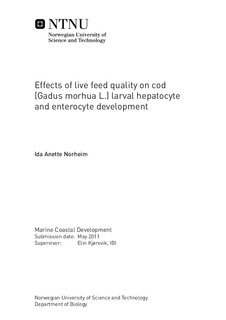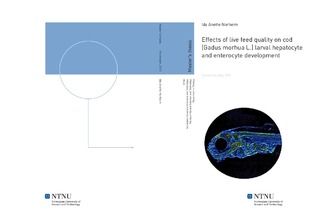| dc.description.abstract | Production of high quality juveniles is still a bottleneck in the intensive culture of cod (Gadus morhua L.), and suboptimal nutrition at the larvae s early life stages is one of the decisive factors for this. The cod larva hatches from small pelagic eggs, and has to start exogenous feeding shortly after hatching when it still lacks a functional stomach. Optimal feeding conditions are therefore crucial for the vulnerable larva at this early developmental stage. Copepod nauplii as live feed may provide nutritional benefits in terms of containing essential fatty acids in the phospholipid fraction that may be incorporated directly into membrane phospholipids, and also containing high amounts of free amino acids compared to rotifers and Artemia sp., which is applied as live feed in intensive production of cod today. The aim of the present study was to examine the effects of feeding with the intensively reared copepod Acartia tonsa compared to both enriched and unenriched rotifers (Brachionus ibericus), in terms of growth, survival, and functional development of the liver and gut. The liver and gut from larvae at 4 and 19 days post hatching (dph) was examined by performing quantitative measurements by stereology, and qualitative histological measurements on hepatocyte and enterocyte appearance. Mitochondrial development was given special emphasise to evaluate if there are tendencies implying a development in morphology of these energy producing organelles, and also whether they are affected by the nutritional composition of the live feed organisms.Feeding with copepod nauplii instead of enriched rotifers resulted in higher growth, survival, and increased pigmentation of the cod larvae. In addition it was found that feeding with rotifers, and especially with the unenriched type, showed signs of mitochondrial dysfunction in terms of cristae interdigitation within both hepatocytes and enterocytes. This was not found in the copepod-fed larvae, which might be attributed to providing phospholipid in the diet that may enhance normal development of biomembranes. Glycogen deposits were found in the hepatocytes in larvae at 19 dph, although to a much greater extent in the larvae fed rotifers, which might be due to differences in carbohydrate content in the different live feed organisms. The liver tissue was generally more evidently reflecting developmental processes between 4 dph and 19 dph and the effect of the live feeds nutritional value on the metabolic energy state of the larvae, than what the gut tissue did. | nb_NO |

